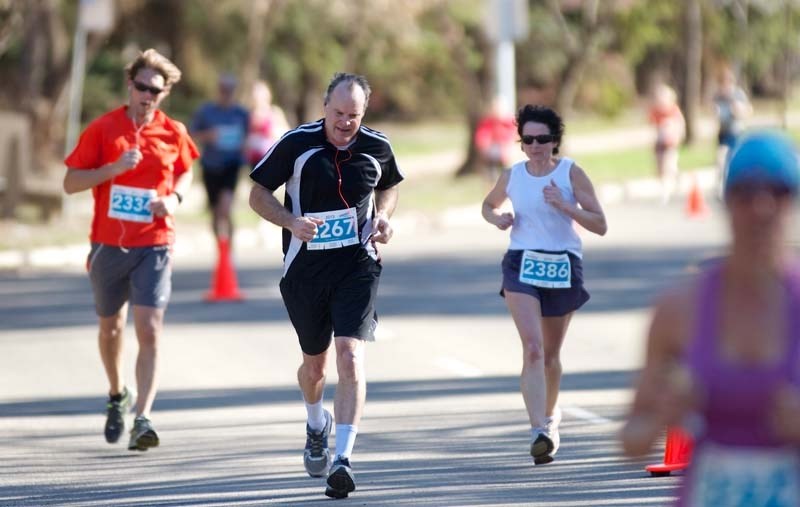This is the first of a three-part series the Gazette will be doing on endurance running.
With a slew of running events slated for the summer and into the fall, many endurance runners are already heavily immersed into their training schedules, which in some cases resemble: eat, sleep, work, run.
Keeping up with a disciplined training routine is not only intimidating for an amateur runner, but even a seasoned athlete.
This is why, experts say, runners need to take it slow and steady.
“Sometimes runners and athletes bite off more than they can chew,” admitted Marc Meunier, two-time RunWild marathon winner. “You want to finish a race feeling good, and if you don’t that might deter you from continuing on.”
In order to keep making it to the finish line, runners need to be aware of their bodies and have realistic expectations.
“I use the analogy of a fishing line,” said James Dean, physiotherapist at Dynamic Sports Physiotherapy and St. Albert Physical Therapy & Sports Injury Clinic.
“With lots of training you build up that strength of the fishing line, but if you have a 40-pound fishing line and you try to catch a 50-pound fish, it’s going to snap.”
Dean is no stranger to treating sports injuries and has seen, time and time again, individuals attempt to complete a long distance run – 10 km, half-marathon, marathon – without properly training.
Too much ambition and not enough practice can result in injury. Dean explained the most common affliction he treats in runners is knee pain, often due to weakness of the gluteus medius muscle of the buttocks.
Knee pain can develop when the outside of the quad muscle (used to extend the knee) and the iliotibial band (IT band) – used to rotate the hip – tighten and pull the kneecap to the side.
The gluteus medius can become so weak that it becomes unable to maintain both hips at the same level. When the hip and knee of the normal side are flexed, the pelvis sags on the opposite side.
“That happens to runners when their fishing line breaks, so to speak. You see their butt starting to drop,” said Dean. “Often I say that people get lazy and they’re not using their butt muscle. If they can start activating that often it will be enough to get the knee pain to go away.”
If caught early, recovery is quick, said Dean, but often the injury is built up over a period of weeks to months and can lead to issues with other muscle groups.
Many people have weak glutes due to their sedentary lifetyles. Sitting for long periods of time shortens and tightens quads, hamstrings, hip flexors, IT bands and even the Achilles tendon.
Dean stressed the importance of knowing how it feels when each muscle group is firing and for athletes to carry it into their running.
“You need a good balance of muscles, make sure the bigger muscles are doing their work not the smaller ones, and making sure that kneecap is tracking properly.”
Paying attention to pain and taking a smart course of action – reducing the mileage and intensity of runs, working out isolated muscle groups, seeking medical treatment or taking time off – can make the difference between a speedy recovery and chronic injury.
Runners are prone to several injuries including: “runners’ knee” or patellofemoral pain syndrome, Achilles tendinitis, hamstring issues, plantar fasciitis, shinsplints, iliotibial band syndrome and stress fractures.
“Maintenance is key as far as having a lifelong career as a runner,” added Jonathan Tong, physiotherapist at Sturgeon Valley Physiotherapy. “The weekend warrior mentality doesn’t lend itself to marathons.”
As crucial as it is to not overwork your body, being careful not to fatigue your mind is also important.
“(Injuries), I find most runners can overcome, but sometimes just the mental stress is what burns runners out and could sideline them for a long time,” noted avid runner Meunier, adding it’s essential for athletes not to forget the reason why they’re running.
“The feeling of crossing that finish line is like no other,” he said.
“Everybody who crosses that finish line feels that same power, feels that same excitement, that’s what it’s all about. That feeling of accomplishment, that’s what keeps you coming back.”
Preventative exercises for runners
• side-lying hip abduction exercises<br />• one-leg squats<br />• one-leg deadlifts<br />• lateral band walk<br />• side lunges<br />• side planks<br />• toe crunches<br />• IT band stretch using a foam roller




